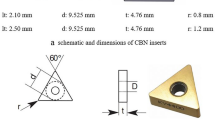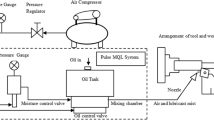Abstract
Hard turning with ceramic tools provides an alternative to grinding operation in machining high precision and hardened components. But, the main concerns are the cost of expensive tool materials and the effect of the process on machinability. The poor selection of cutting conditions may lead to excessive tool wear and increased surface roughness of workpiece. Hence, there is a need to investigate the effects of process parameters on machinability characteristics in hard turning. In this work, the influence of cutting speed, feed rate, and machining time on machinability aspects such as specific cutting force, surface roughness, and tool wear in AISI D2 cold work tool steel hard turning with three different ceramic inserts, namely, CC650, CC650WG, and GC6050WH has been studied. A multilayer feed-forward artificial neural network (ANN), trained using error back-propagation training algorithm has been employed for predicting the machinability. The input–output patterns required for ANN training and testing are obtained from the turning experiments planned through full factorial design. The simulation results demonstrate the effectiveness of ANN models to analyze the effects of cutting conditions as well as to study the performance of conventional and wiper ceramic inserts on machinability.
Similar content being viewed by others
References
Konig W, Berktold A, Koch KF (1993) Turning versus grinding—a comparison of surface integrity aspects and attainable accuracies. Annals of CIRP 42(1):39–43
Tonshoff HK, Arendt C, Ben Amor R (2000) Cutting of hardened steel. Annals of CIRP 49(2):547–566
Zou JM, Anderson M, Stahl JE (2004) Identification of cutting errors in precision hard turning process. J Mater Process Technol 153–154:746–750
Rech J, Moisan A (2003) Surface Integrity in finish hard turning of case hardened steels. Int J Mach Tools Manuf 43:543–550
Destefani J (2004) Technology key to mold making success. Manuf Eng 133(4):59–64
Elbestawi MA, Chen L, Becze CE, EI-Wardany TI (1997) High-speed milling of dies and molds in their hardened state. Annals of CIRP 46(1):57–62
Byrne G, Dornfeld D, Denkena B (2003) Advancing cutting technology. Annals of CIRP 52(2):483–507
Klocke F, Brinskmeier E, Weinert K (2005) Capability profile of hard cutting and grinding processes. Annals of CIRP 54(2):557–580
GuoYB SJA (2004) Comparative study of hard turned and cylindrically ground white layers. Int J Mach Tools Manuf 44:135–145
Thiele JD, Melkote SN, Peascoe RA, Watkins TR (2000) Effect of cutting edge geometry and workpiece hardness on surface residual stresses in finish hard turning of AISI 52100 steel. ASME J Manuf Sci Eng 122:642–649
Huang Y, Liang SY (2003) Cutting forces modeling considering the effect of tool thermal property—application to CBN hard turning. Int J Mach Tools Manuf 43:307–315
ChouYK ECJ (1997) Tool wear mechanism in continuous cutting of hardened tool steels. Wear 212:59–65
Chou YK, Evans CJ, Barash MM (2002) Experimental investigation on CBN turning of hardened AISI 52100 steel. J Mater Process Technol 124:274–283
Thiele JD, Melkote SN (1999) Effect of cutting edge geometry and workpiece hardness on surface generation in the finish hard turning of AISI 52100 steel. J Mater Process Technol 94:216–226
Ozel T, Hsu T-K, Zeren E (2000) Effects of cutting edge geometry, workpiece hardness, feed rate and cutting speed on surface roughness and forces in finish turning of hardened AISI H13 steel. Int J Adv Manuf Technol 25(3–4):262–269
Kishawy HA, Elbestawi MA (2000) Tool wear and surface integrity during high-speed turning hardened steel with polycrystalline cubic boron nitride tools. J Eng Manuf 215:755–767
EI-Wardany TI, Kishawy HA, Elbestawi MA (2000) Surface integrity of die material in high-speed hard machining, part 1, micro graphical analysis. ASME J Manuf Sci Eng 122(4):620–631
EI-Wardany TI, Kishawy HA, Elbestawi MA (2000) Surface integrity of die material in high-speed hard machining, part 2, micro hardness variations and residual stresses. ASME J Manuf Sci Eng 122(4):632–641
Poulachon G, Bandyopadhyay BP, Jawahir IS, Pheulpin S, Seguin E (2003) The influence of the microstructure of hardened tool steel workpiece on the wear of PCBN cutting tools. Int J Mach Tools Manuf 43:139–144
Lima JG, Avila RF, Abrao AM, Faustino M, Davim JP (2005) Hard turning AISI 4340 high strength low alloy steel and AISI D2 cold work steel. J Mater Process Technol 169:388–395
Pavel R, Marinescu I, Deis M, Pillar J (2005) Effect of tool wear on surface finish for a case of continuous and interrupted hard turning. J Mater Process Technol 170:341–349
Diniz AE, Oliveira AJ (2008) Hard turning of interrupted surfaces using CBN tools. J Mater Process Technol 95:275–281
Chou YK, Song H (2004) Tool nose radius effects on finish turning. J Mater Process Technol 148:259–268
Kumar AS, Durai R, Sornakumar T (2003) Machinability of hardened steel using alumina based ceramic cutting tools. Int J Refract Met Hard Mater 21:109–117
Benga GC, Abrao AM (2003) Turning of hardened 100Cr6 bearing steel with ceramic and PCBN cutting tools. J Mater Process Technol 143–144:237–241
Grzesik W, Wanat T (2005) Comparative assessment of surface roughness produced by hard machining with mixed ceramic tools including 2D and 3D analysis. J Mater Process Technol 169:364–371
Grzesik W, Wanat T (2006) Hard turning of quenched alloy steel parts using conventional and wiper ceramic inserts. Int J Mach Tools Manuf 46:1988–1995
Grzesik W (2008) Influence of tool wear on surface roughness in hard turning using differently shaped ceramic tools. Wear 265:327–335
Schwach DW, Guo YB (2005) Feasibility of producing optimal surface integrity by process design in hard turning. Mater Sci Eng 395:116–123
Quiza R, Figueira L, Davim JP (2008) Comparing statistical models and artificial networks on predicting the tool wear in hard machining D2 AISI steel. Int J Adv Manuf Technol 37:641–648
Ozel T, Karpat Y (2005) Predictive modeling of surface roughness and tool wear in hard turning using regression and neural networks. Int J Mach Tools Manuf 4:467–479
Davim JP, Figueira L (2007) Machinability evaluation in hard turning of cold work tool steel (D2) with ceramic tools using statistical techniques. Mater Des 28:1186–1191
Klocke F, Kratz H (2005) Advanced tool edge geometry for high precision hard turning. Annals of CIRP 54(1):47–50
Ozel T, Karpat Y, Figueira L, Davim JP (2007) Modelling of surface finish and tool flank wear in turning of AISI D2 steel with ceramic wiper inserts. J Mater Process Technol 189:192–198
Davim JP, Figueira L (2007) Comparative evaluation of conventional and wiper ceramic tools on cutting forces, surface roughness and tool wear in hard turning AISI D2 steel. J Eng Manuf 221:625–633
Gaitonde VN, Karnik SR, Figueira L, Davim JP (2009) Machinability investigations in hard turning of AISI D2 cold work tool steel with conventional and wiper ceramic inserts. Int J Refract Met Hard Mater 27(4):754–763
Montgomery DC (2004) Design and analysis of experiments, 5th edn. Wiley, New York
Karnik SR, Gaitonde VN, Davim JP (2008) A Comparative study of the ANN and RSM modeling approaches for predicting burr size in drilling. Int J Adv Manuf Technol 38:868–883
Karnik SR, Gaitonde VN, Mata F, Davim JP (2008) Investigative study on machinability aspects of unreinforced and reinforced PEEK composite machining using ANN model. J Reinf Plast Compos 27(7):751–768
Karnik SR, Gaitonde VN, Rubio JC, Correia AE, Abrao AM, Davim JP (2008) Delamination analysis in high speed drilling of carbon fiber reinforced plastics (CFRP) using artificial neural network model. Mater Des 29:1768–1776
Davim JP, Gaitonde VN, Karnik SR (2008) Investigations into the effect of cutting conditions on surface roughness in turning of free machining steel by ANN models. J Mater Process Technol 205:16–23
Schalkoff RB (1997) Artificial neural networks. McGraw-Hill, Singapore
Fausett L (1994) Fundamentals of neural networks: architectures, algorithms and applications. Prentice–Hall, New York
Math Works Incorporation (2005) MATLAB User Manual, Version 7.1, R 14. Natick, MA
Author information
Authors and Affiliations
Corresponding author
Rights and permissions
About this article
Cite this article
Gaitonde, V.N., Karnik, S.R., Figueira, L. et al. Performance comparison of conventional and wiper ceramic inserts in hard turning through artificial neural network modeling. Int J Adv Manuf Technol 52, 101–114 (2011). https://doi.org/10.1007/s00170-010-2714-3
Received:
Accepted:
Published:
Issue Date:
DOI: https://doi.org/10.1007/s00170-010-2714-3




